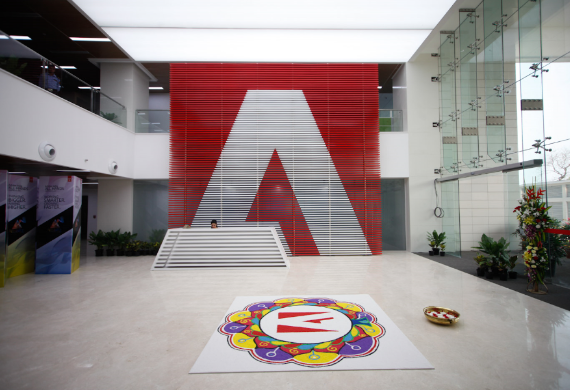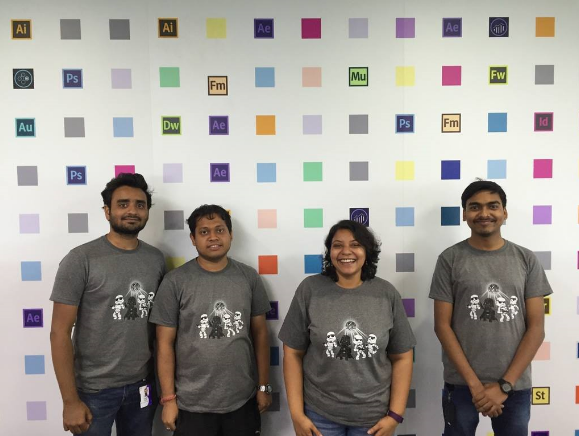

Body of IITR

Tathagata Sengupta is a 5th year student in the Department of Mathematics. Read on as he recounts his experience of interning with Adobe, Bangalore during the summers of 2016.
To begin with, yes, CGPA did matter while applying it on campus (actually it is your department rank which gets you shortlisted for the company). As a matter of fact, I never found a single person below the 8.5 mark in the research team, so it’s safe to assume the cut-off to be the same. However, I’m not exactly sure about the product team which was mainly based in Noida.

There was a first round of online test asking you simple questions on probability, ad-hoc algorithms, a short essay on how to make the world a smarter place. This was followed by a telephonic interview which is generally taken by junior members of the research / product team. You can expect questions from basic data structures and algorithms, probability theory, discrete mathematics etc. I was asked questions from Real Analysis for which I gave a proof from Walter Rudin’s book on the same. I’ll advise against it though. For tips regarding the interviews, chill. They are statistically random.
Even though Adobe is mainly known for its Creative Cloud, the research team based in Bangalore mainly collaborates in the area of Marketing Cloud. They have huge data centres installed wherein they get data from the Adobe Analytics software. Hence the projects are mainly in areas of data analysis, machine learning and natural language processing (some things you’ll hear quite regularly).
Prior to the initiation, a team of three is formed taking into consideration the variability among the members in terms of the institute and their majors. A broad topic is then assigned to each team along with a mentor. Mentors vary from a wide spectrum; from statisticians to communications engineer.
The entire internship programme was divided into three parts. In the first three weeks, of our internship, we were asked to delve into the problem domain related to our broad topic. We have to come up with some what 80+ problem statements and ideas. These ideas must be well posed and should be backed by some literature. In order to do this, we were provided free access to various conferences and journals of the likes of ACM, IEEE etc along with marketing journals like Forrester, etc. My team’s broad topic was “Persuasive Online Content”, hence our ideas mainly focussed on the different technical and marketing aspects leading to persuasion. This included ideas in the domain of UX, image processing, language processing, social media analytics, art theory etc. During this time, we interacted with multiple mentors whose specialization involves any one of our idea cluster. We interacted with the people from UX team as well. Focus is mainly on this aspect as in corporate research, coming up with a problem is equally important as finding its solution.
 Team Coax
Team Coax
Next part of the internship mainly focussed on finding the solution to our problem which involves things that I’m bound not to disclose. It was mainly coming up with a model which estimates the persuasion score of any content based upon the training data set obtained from the campaign analytics from Adobe database. The final part was to come up with a demo and write the IP and papers of the work we did.
The timings were “flexible”, which meant that you are allowed to work 24x7 as long as you take a bath every once in a week. Lunch and dinner was free as an incentive. There was a pantry which had unlimited supply of chai, coffee (filter or CCD), soft drinks (as hard ones was strictly prohibited within the campus), biscuits and masala oats (acquired taste). There were rumours regarding availability of Maggi somewhere in the 10 floor pantry which was never substantiated. And of course, there was free pizza (order amount refundable) every Sunday. So work ceased to be work when you are munching the whole time.
The work culture is not akin to the other corporate sectors; people are mainly focussed on research rather than development. Much focus is provided to reading the research papers and coming up with ideas to improve upon the limitations provided in them. The mentors encourage the interns to go for higher studies prior to joining them as it would open up new avenues for thought process which is required in a corporate research environment.
Bangalore is well known for its cool, pristine weather throughout the year with natural breeze blowing. BS. It was always raining. And being near to Marathahalli, you’ll be missing all the action you have heard about this place. So it’s a hell lot of traffic and mud and waterlogged streets. Trips to Koramangala, just 7 km away and you find some of the best English cafes and restaurants.
Adobe Research is a good company to intern at if you are eager to join the corporate research sector. You will gain experience in some of the coolest research areas like Machine Learning, Natural Language Processing, Image Processing etc. However, some of the tips to make your intern a successful one :
If you have an internship experience you’d like to share, get in touch at watchout.iitr@gmail.com